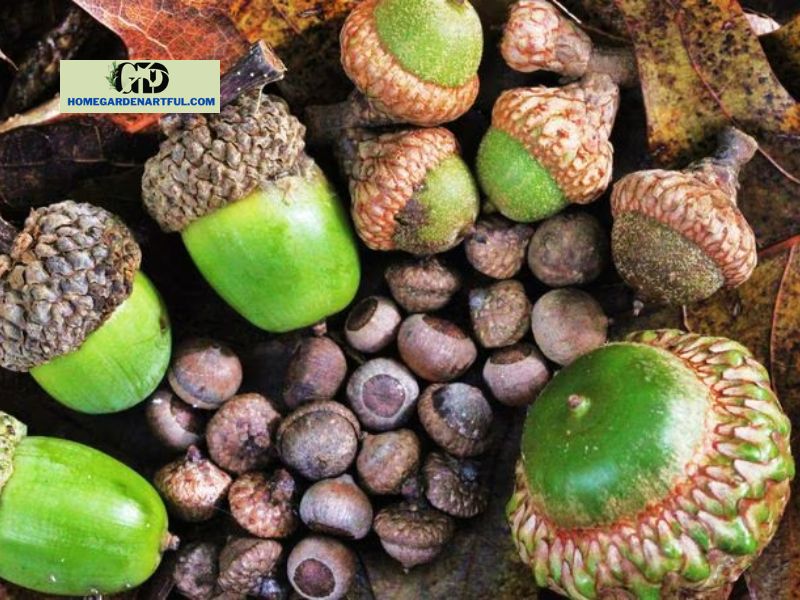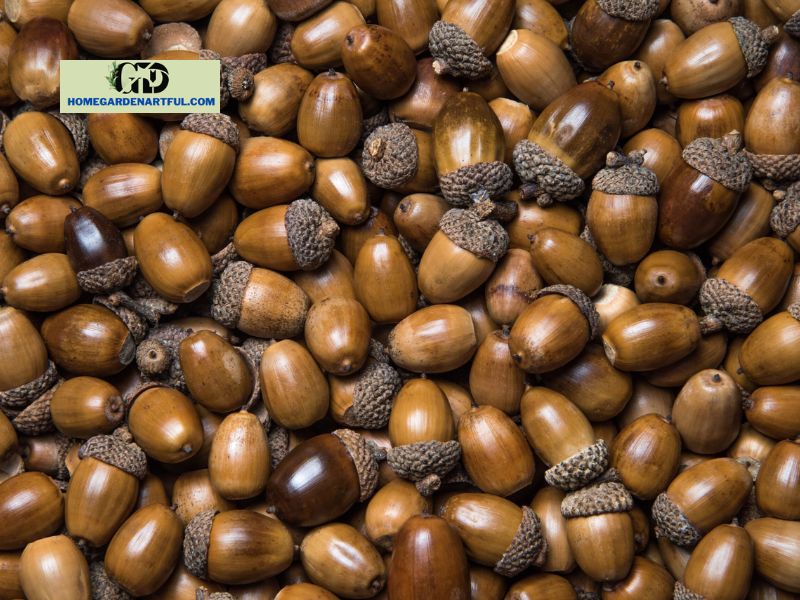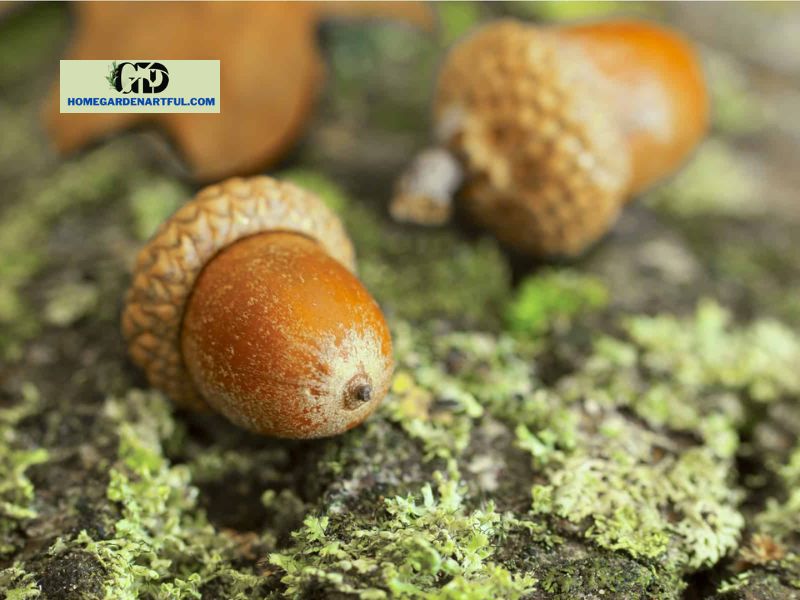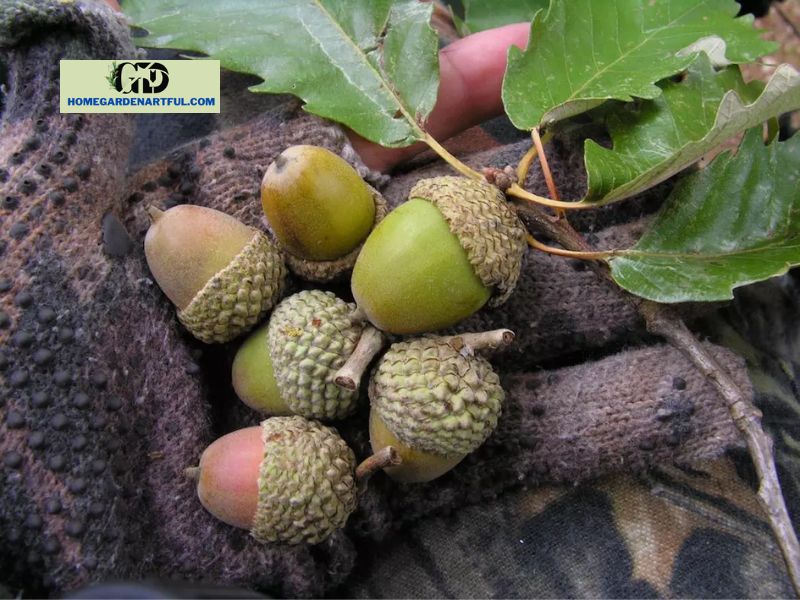Do you know the Types Of Acorns? The nut of oak trees is known as an acorn or oaknut. One or two oak seeds are contained inside each acorn, which is protected by a hard outer shell. Acorns feature a characteristic oval form with a cupule, which is a scaly or warty cap. Typically, it takes 6 to 24 months for the edible acorns to reach maturity.
The properties of acorns may typically be used to determine the species of an oak tree. For instance, some acorns have a round, blunt tip, while others have an oblong, pointy tip. Acorns come in a variety of colors, ranging from traditional brown to green, reddish-brown, chestnut red, and even black.
This article from homegardenartful.com serves as a manual for classifying acorns based on their size, color, shape, and Types Of Acorns. The various species of oak trees in a landscape can be identified with the aid of this useful knowledge.
Describe an acorn

The acorn is an oak tree’s fruit. One or two sizable seeds are contained in each acorn or oak nut, which has a cup-shaped crown and a thick protective shell around it. A plentiful acorn harvest typically happens every four years or so, and the edible acorn nut typically matures in six to 24 months.
Acorn Identification

Acorns from each type of oak tree are unique. An acorn can be distinguished by its cup, color, shape, and size. The woody cup of the acorn may be hairy, smooth, or scaly. Acorns typically have an oval or spherical form, and some varieties have very tiny ridges. Acorns can turn brown, crimson, or black as they mature.
How to tell what Types Of Acorns you have is as follows:
1. Examine the acorn’s cup scales
Look at the hat-shaped woody cup to determine the sort of acorn. Native American acorns in North America have overlapping scale-covered cups. Next, consider how much of the cupule is encircling the nut. Some acorn cups can completely enclose the length of the nut. Some acorn varieties have narrow, shallow crowns.
2. Determine an acorn’s form
Acorns from different oak species have different forms and sizes. Acorns often come in two shapes: round or oblong. If you look attentively, you could spot fine parallel ridges extending up to the tip. Additionally, although some acorns have smooth, rounded heads, others have pointy tips.
3. Determine an acorn’s color
The color of an adult acorn can be used to identify the type of oak. Oak nuts can turn light brown, reddish brown, dark brown, purplish red, or even black as they develop. Acorns that are green on the ground have typically fallen from the oak tree before reaching maturity.
4. Determine an acorn’s size
The size variation among acorns aids in determining the species of oak tree. Acorn nuts are as small as 0.5″ (12 mm) in diameter. The bur oak produces the largest acorns, which can range in size from 2″ to 3″ (50 mm to 75 mm).
Observe the cup’s size as well. Some varieties of acorns have cups that nearly completely encircle the base of the nut. Other varieties barely do.
5. Examine an acorn’s hairs to determine its species
Another distinguishing characteristic of the acorn cup is the presence of hairs. The majority of oak species yield stiff, woody acorns with scaly cupules. Acorns of other varieties have woolly cups covered in long, tangled hairs. Then there are acorn species with cups that are smooth and untextured.
Do Acorns Taste Good?
Acorns are edible nuts that can be roasted, crushed into flour, or used to make a beverage that tastes like coffee but doesn’t contain any caffeine. Raw acorns, however, contain a tannin with a strong aftertaste that may be hazardous to people. Acorns must first be leached to eliminate the tannin before being consumed in order to improve their flavor and make them safe for consumption. Soak and then drain the acorns in water to remove the tannin and make them palatable. Continue doing this until the water is clear.
Types Of Acorns

It’s essential to recognize the tastiest nut variety if you want to consume excellent acorns. From early April through September, acorns are harvested. It would be ideal to look for mature acorns with solid, leathery shells that don’t have any holes in them.
Acorns with the least tannin content are the sweetest and easiest to prepare. Pin oaks, burr oaks, east coast white oaks, and cork oaks are examples of oak species that produce tasty acorns.
The largest acorns typically have a hairy cupule. East Coast white oaks, burr oaks, and California black oaks are the types of oak trees that produce the biggest acorns.
Acorns from the eastern red oak and black oak are the fattest, so use those if you intend to create acorn oil. Of all the acorn varieties, these nuts typically have the highest oil content.
Acorns that are the smallest tend to be rounded as well as flattened and are not good for eating. The cherry bark oak and chinquapin oak produce the tiniest acorns.
Red oak acorns versus white oak acorns
White oaks and red oaks are the two main types of native oak trees in North America. The form is the primary distinction between red and white oak acorns. Acorns from red oaks are rounder and flatter, but acorns from white oaks tend to be longer and oval.
How to Collect Oak Leaves
Acorns are harvested in the fall, right after they have fallen from an oak tree. The largest nuts with the smallest tops are the sweetest acorns. Generally, the tannin content of these is lower. To keep them from becoming moldy, dry them indoors after gathering them.
Acorns with tiny holes should always be thrown away since they indicate weevil activity. Throw away any acorns that have green seeds as well.
How to Process Acorns
Leach the tannins from acorns before eating them. Acorns should be soaked and rinsed in cold water til the water is clear to remove the tannins. Depending on how long it takes for all of the tannins to leach out of the acorn meat, the leaching process could take several days. Remove the shells next. Allowing the acorns to dry out, though, might make shelling them simpler. The black skins on the acorn seeds should be removed after shelling them because they contain bitter tannins.
Put the acorn nuts in cold water to stop them from oxidizing. You can then start using them to make acorn flour.
Acorns can be more easily enjoyed by roasting them for 60 minutes at 350°F (180°C) in the oven. To get the tannins out, it would still be preferable to leech them.


